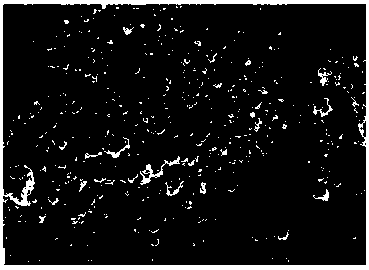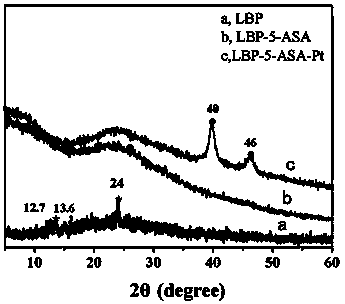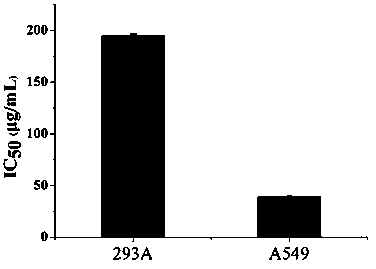Lycium barbarum polysaccharide modified nano particle preparation and anti-tumor activity research
An anti-tumor activity, Lycium barbarum polysaccharide technology, applied in the direction of anti-tumor drugs, organic active ingredients, medical preparations of non-active ingredients, etc., can solve the problems of reduced drug efficacy, poor selectivity, fast metabolism, etc. and toxic side effects
- Summary
- Abstract
- Description
- Claims
- Application Information
AI Technical Summary
Problems solved by technology
Method used
Image
Examples
Embodiment 1
[0026] 500 mg of Lycium barbarum polysaccharide was completely dissolved with 100 mL of pH=2 buffer solution, then 500 mg of 5-aminosalicylic acid (5-ASA) was added and stirred at 25°C for 24 h, then 500 mg of compound 1 was added once Add the solution to the above mixed solution, react at room temperature for 24 hours, place the mixed solution in a dialysis bag (MWCO: 3500 Da) and dialyze with deionized water for 48 hours, and freeze-dry the solution to obtain composite nanoparticles LBP / 5-ASA / Pt.
[0027] Lung cancer cells (A549) and normal hepatocytes (293A) were incubated with 100.0 μL of 1640 medium and DMEM for 24 h, respectively, and 100 μL of 40 μg / mL composite nanoparticles LBP / 5-ASA / Pt After 48 hours of treatment, MTT (20 μL 5 mg / mL) was added, and placed in an incubator to continue culturing for 4 hours. The purple precipitate produced in the separation system was dissolved in 200 μL dimethyl sulfoxide solution, and the absorbance was measured. The IC 50 They are ...
Embodiment 2
[0029] 500 mg of Lycium barbarum polysaccharide was completely dissolved in 100 mL of pH=5 buffer solution, then 500 mg of 5-aminosalicylic acid (5-ASA) was added and stirred at 25°C for 24 h, and 500 mg of compound 1 was dissolved in one time Add the above mixed solution, react at room temperature for 24 hours, place the mixed solution in a dialysis bag (MWCO: 3500 Da) and dialyze with deionized water for 48 hours, and freeze-dry the solution to obtain composite nanoparticles LBP / 5-ASA / Pt .
[0030] Lung cancer cells (A549) and normal liver cells (293A) were incubated with 100.0 μl of 1640 medium and DMEM base for 24 h, respectively, and 100 μL, 40 μg / mL of composite nanoparticles LBP / 5-ASA / Pt, after 48 hours of treatment, MTT (20 μL 5 mg / mL) was added, placed in the incubator for 4 hours, and the purple precipitate produced in the separation system was dissolved in 200 μL dimethyl sulfoxide solution, and the absorbance was measured. The IC 50 They were 40 μg / mL and 195 μg / ...
Embodiment 3
[0032] 500 mg of Lycium barbarum polysaccharide was completely dissolved with 100 mL of pH=7 buffer, then 500 mg of 5-aminosalicylic acid (5-ASA) was added and stirred at 25°C for 24 h, then 500 mg of compound 1 was added once Add the solution to the above mixed solution, react at room temperature for 24 hours, place the mixed solution in a dialysis bag (MWCO: 3500 Da) and dialyze with deionized water for 48 hours, and freeze-dry the solution to obtain composite nanoparticles LBP / 5-ASA / Pt.
[0033] Lung cancer cells (A549) and normal liver cells (293A) were incubated with 100.0 μl of 1640 medium and DMEM base for 24 h, respectively, and 100 μL, 40 μg / mL of composite nanoparticles LBP / 5-ASA / Pt, after 48 hours of treatment, MTT (20 μL 5 mg / mL) was added, placed in the incubator for 4 hours, and the purple precipitate produced in the separation system was dissolved in 200 μL dimethyl sulfoxide solution, and the absorbance was measured. The IC 50 They were 107 μg / mL and 182 μg / ...
PUM
 Login to View More
Login to View More Abstract
Description
Claims
Application Information
 Login to View More
Login to View More - R&D
- Intellectual Property
- Life Sciences
- Materials
- Tech Scout
- Unparalleled Data Quality
- Higher Quality Content
- 60% Fewer Hallucinations
Browse by: Latest US Patents, China's latest patents, Technical Efficacy Thesaurus, Application Domain, Technology Topic, Popular Technical Reports.
© 2025 PatSnap. All rights reserved.Legal|Privacy policy|Modern Slavery Act Transparency Statement|Sitemap|About US| Contact US: help@patsnap.com



